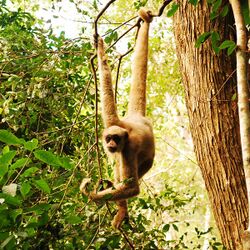Biology:Muriqui
From HandWiki
Revision as of 22:15, 17 May 2021 by imported>TextAI (over-write)
| Muriquis[1] | |
|---|---|

| |
| Northern muriqui, Brachyteles hypoxanthus | |
| Scientific classification | |
| Domain: | Eukaryota |
| Kingdom: | Animalia |
| Phylum: | Chordata |
| Class: | Mammalia |
| Order: | Primates |
| Suborder: | Haplorhini |
| Infraorder: | Simiiformes |
| Family: | Atelidae |
| Subfamily: | Atelinae |
| Genus: | Brachyteles Spix, 1823 |
| Type species | |
| Ateles arachnoides É. Geoffroy, 1806
| |
| Species | |
|
Brachyteles arachnoides | |
The muriquis, also known as woolly spider monkeys, are the monkeys of the genus Brachyteles.[1] They are closely related to both the spider monkeys and the woolly monkeys.[1] The two species are the southern (B. arachnoides) and northern (B. hypoxanthus) muriquis.[1] They are the two largest species of New World monkeys, and the northern species is one of the most endangered of all the world's monkeys.[2]
The muriqui is the largest monkey in South America.[3] Males are the same size and weight as females.[4] It lives primarily in coffee estates in Southeastern Brazil.[3]
References
- ↑ 1.0 1.1 1.2 1.3 Groves, C. P. (2005). "Order Primates". in Wilson, D. E.; Reeder, D. M. Mammal Species of the World: A Taxonomic and Geographic Reference (3rd ed.). Johns Hopkins University Press. pp. 151. ISBN 978-0-8018-8221-0. OCLC 62265494. http://www.departments.bucknell.edu/biology/resources/msw3/browse.asp?id=12100408.
- ↑ Chaves, Paulo B.; Alvarenga, Clara S.; Possamai, Carla de B.; Dias, Luiz G.; Boubli, Jean P.; Strier, Karen B.; Mendes, Sérgio L.; Fagundes, Valéria (3 June 2011). "Genetic diversity and population history of a critically endangered primate, the northern muriqui (Brachyteles hypoxanthus)". PLoS ONE 6 (6): e20722. doi:10.1371/journal.pone.0020722. PMID 21694757. PMC 3108597. http://www.plosone.org/article/info%3Adoi%2F10.1371%2Fjournal.pone.0020722.
- ↑ 3.0 3.1 Richard Wrangham & Dale Peterson (1997). Demonic Male: Apes and the Origins of Human Violence. Bloomsbury. p. 174.
- ↑ Richard Wrangham & Dale Peterson (1997). Demonic Male: Apes and the Origins of Human Violence. Bloomsbury. p. 175.
Further reading
- Mittermeier, Russell A. (March 1987). "Monkey in Peril". National Geographic 171 (3). ISSN 0027-9358. OCLC 643483454.
External links
- Conservation of the Muriqui from Brazil
- Primate Info Net Brachyteles Factsheet
- Southern Muriqui Home Page - Pró- Muriqui Association
Wikidata ☰ Q857477 entry

